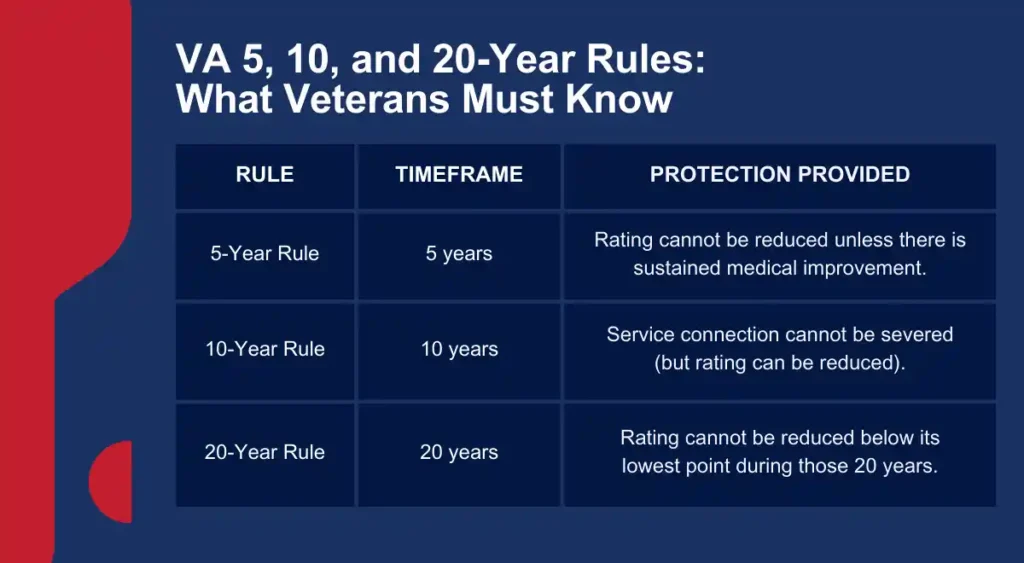You fought for your country and came home with scars, both seen and unseen. Getting your VA disability rating felt like a major victory, a validation of your sacrifice. But now, a small worry might be nagging at you: Can the VA take it away? This is a fear many veterans share.
The good news is that the VA has systems in place to give you peace of mind. These VA rules protect your disability rating over time. Find out how the 5, 10 and 20-year rules could lock in your benefits.
Getting that rating was a long road, and you do not want to live with the stress of it being lowered. That is why understanding your rights is so important. Knowing about these protections helps you stand on solid ground.

What Are Protected VA Ratings?
The VA generally has the right to re-examine your service-connected disabilities. If they believe your connected condition has improved, they can propose a rating reduction. It is a process that can feel unfair and incredibly stressful for any disabled veteran.
But the VA cannot just change your VA disability rating on a whim. They have rules to follow, and these rules get stronger the longer you have your rating. Think of these rules as shields that grow tougher over time, safeguarding the disability benefits you depend on.
These protections are not automatic for everyone but are based on specific time milestones. We are talking about the 5, 10, and 20-year rules. Each one offers a different level of security for your veterans disability compensation.
The 5-Year Rule: Building a Foundation
The first milestone in protecting your VA disability is the 5-year rule. Once your disability rating has been in place for five years, it becomes a stabilized rating. This provides the first important layer of protection for your benefits.
What does a stabilized rating really mean? It means the VA can no longer propose a rating reduction based on a single medical exam that suggests you are doing better. They need much more evidence than that to change your established disability ratings.
To lower a rating that has passed the five-year mark, the VA must have solid medical evidence showing your condition has experienced sustained improvement. One good day or even a good month is not enough. The improvement needs to be documented over time and show that it is likely to be permanent.
The burden of proof shifts to the VA. They have to do the work to show you have truly gotten better. Before this five-year point, it was easier for them to make a case for reduction, but now the tables have turned.
According to the government’s own regulations, this evidence must be thorough. It has to show a real change in your ability to function in your daily life, not just a minor fluctuation in symptoms for conditions like chronic pain or a depressive disorder. It is a significant hurdle for them to clear.
The 10-Year Rule: Protecting Your Service Connection
The next major milestone for your VA disability ratings comes at the 10-year mark. This rule is a big one because it protects the most important part of your disability claim: the service connection itself. This means the VA agrees your disability is because of your military service.
Once a disability has been service-connected for 10 years or more, the VA cannot sever that service connection. They cannot suddenly say they were wrong and your condition is not related to your service after all. That link between your condition and your time in the military is locked in for good.
There is only one exception to this rule: fraud. If the VA can prove you committed fraud to get the original rating for a service connected condition, they can take it away. Proving fraud is extremely rare and very difficult for the VA to do.
It is important to understand what this rule does and does not do. While the VA cannot break the service connection, they can still reduce the rating percentage if there is evidence of sustained improvement. For example, your 30% rating for degenerative disc disease could be lowered to 10% if medical evidence supports it.
Even if a rating is reduced to 0%, keeping the service connection is valuable. You can still get VA healthcare for that condition, such as hearing loss or neck pain. And if it gets worse down the road, you can file for an increase without having to prove the service connection all over again, simplifying future VA claims.

The 20-Year Rule: The Ultimate Shield
The 20-year mark offers the strongest protection available for your VA disability rating. Many veterans think of this as the final finish line for their disability claim. It offers a level of security that brings immense relief.
Once your disability has been rated at a certain percentage for 20 continuous years, that rating becomes protected. The VA cannot reduce it below that 20-year level. It is locked in, solid, and secure for the future.
Let us break this down with an example. Say you have had a 50% rating for PTSD for 21 years. The VA cannot, under any circumstances, reduce that rating below 50%. It can go up if your condition worsens, but it cannot go down.
This rule is incredibly powerful for long-term planning. It provides veterans and their families with the ability to manage their future without the fear of a sudden drop in income. You have earned this stability through years of living with your service-related disability.
Just like the other year rules, the only way the VA can bypass this protection is if they can prove the original rating was obtained through fraud. As mentioned before, this is not something that happens often in veterans law. This protection applies to many service-connected disabilities, from rheumatoid arthritis to conditions caused by Agent Orange.

What About Permanent and Total (P&T) Ratings?
You might have heard the term Permanent and Total or P&T. It is important to understand how this relates to the protected ratings we have been talking about. P&T status is a special designation the VA gives to veterans whose disabilities are not expected to improve.
This status usually applies to veterans with a combined disability rating of 100% or those receiving TDIU benefits. If your decision letter says you are “considered to be totally and permanently disabled,” you have P&T status. This status provides strong protections against re-evaluations.
However, you do not need a P&T rating to be protected by the 5, 10, and 20-year rules. These year rules apply to any rating, at any percentage, once it has been in place for the required amount of time. They are separate, time-based protections that add security to your veteran’s disability rating.
What Can Trigger a Rating Review?
Knowing what can cause the VA to take another look at your file is just as important as knowing the rules. The VA does not randomly pick files to review. Something usually triggers it.
Filing a new claim for another condition can open your entire file for review. When you submit new condition claims, the VA will often look at your existing ratings to make sure they are still correct. This is a common trigger for a re-evaluation of all your service-connected conditions.
Another trigger is filing for an increase on a current rating. If you feel your knee pain has gotten worse and file for an increase, the VA will re-evaluate that knee. If the evidence somehow suggests it got better, they could propose a reduction instead.
Sometimes the VA schedules a routine re-examination on its own. This is more common in the first few years after a rating is granted, especially if the condition is one that could improve, such as certain shoulder injuries or a somatic symptom disorder. If you get a letter for a Compensation and Pension (C&P) exam, you must go.
What to Do if the VA Proposes a Reduction
Receiving a letter from the VA proposing a rating reduction can be alarming. The key is to act quickly and strategically. You have rights in this situation, and there is a defined appeals process.
First, read the letter carefully. It will state the reason for the proposed reduction and outline your rights and deadlines. Generally, you have 60 days to submit evidence against the reduction and 30 days to request a hearing.
Do not ignore this letter. Gather your medical records that show your condition has not improved. You may want to get a new medical opinion from a private doctor who can provide a detailed report on how your chronic multi-symptom illnesses affect your daily life.
How to Best Protect Your VA Rating
You can be proactive about keeping your rating secure. The most important thing you can do is continue getting regular medical treatment for your service-connected conditions. A consistent medical history is your best defense against a rating reduction.
These records create a paper trail that documents your ongoing struggles. They show that your condition, whether it is sleep apnea or heart disease, still exists and continues to affect your life. Without current records, the VA might assume your condition has improved.
Always attend your scheduled VA appointments. If the VA calls you in for a C&P re-examination, do not skip it under any circumstances. Missing that exam can lead to an automatic reduction or termination of your VA benefits.
Finally, keep copies of everything related to your disability claims. Every VA decision letter, every medical report, every piece of correspondence should be organized and accessible. Being organized gives you the power to defend your veteran’s disability rating if it is ever challenged.

Conclusion
The VA disability system can feel complex. But there are guideposts along the way to protect you. These VA rules were not created to be confusing; they were created to give you long-term stability and peace of mind.
Understanding these protections can lift a huge weight off your shoulders. You earned your disability benefits through your sacrifice and service. Knowing the rules of the system helps you feel more in control of your future.
The journey with the VA does not end when you get your rating. By staying informed about your VA disability ratings and proactive with your healthcare, you can safeguard your benefits for the future. After all, these VA rules protect your disability rating over time; finding out how the 5, 10 and 20-year rules could lock in your benefits is your first step to feeling secure.


